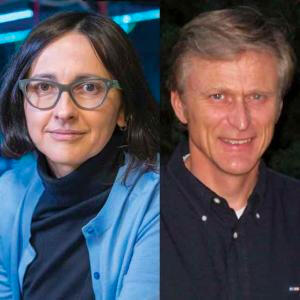
Jelena Vučković and Olav Solgaard are creating an accelerator that fits on a chip
The team wants to accelerate electrons to 94 percent of the speed of light, or 1 million electron volts (1MeV) so that it can be used for research and medical purposes.
A team led by professor Jelena Vučković explained how they carved a nanoscale channel out of silicon, sealed it in a vacuum and sent electrons through this cavity while pulses of infrared light – to which silicon is as transparent as glass is to visible light – were transmitted by the channel walls to speed the electrons along. Their research is published in the January 3 issue of Science. The accelerator-on-a-chip demonstrated in Science is just a prototype, but Vučković said its design and fabrication techniques can be scaled up to deliver particle beams accelerated enough to perform cutting-edge experiments in chemistry, materials science and biological discovery that don't require the power of a massive accelerator.
"The largest accelerators are like powerful telescopes. There are only a few in the world and scientists must come to places like SLAC to use them," Vučković said. "We want to miniaturize accelerator technology in a way that makes it a more accessible research tool."
Team members liken their approach to the way that computing evolved from the mainframe to the smaller but still useful PC. Accelerator-on-a-chip technology could also lead to new cancer radiation therapies, said physicist Robert Byer, a co-author of the Science paper. Again, it's a matter of size. Today, medical X-ray machines fill a room and deliver a beam of radiation that's tough to focus on tumors, requiring patients to wear lead shields to minimize collateral damage.
"In this paper we begin to show how it might be possible to deliver electron beam radiation directly to a tumor, leaving healthy tissue unaffected," said Byer, who leads the Accelerator on a Chip International Program, or ACHIP, a broader effort of which this current research is a part.
The researchers want to accelerate electrons to 94 percent of the speed of light, or 1 million electron volts (1MeV), to create a particle flow powerful enough for research or medical purposes. This prototype chip provides only a single stage of acceleration, and the electron flow would have to pass through around 1,000 of these stages to achieve 1MeV. But that's not as daunting at it may seem, said Vučković, because this prototype accelerator-on-a-chip is a fully integrated circuit. That means all of the critical functions needed to create acceleration are built right into the chip, and increasing its capabilities should be reasonably straightforward.
The researchers plan to pack a thousand stages of acceleration into roughly an inch of chip space by the end of 2020 to reach their 1MeV target. Although that would be an important milestone, such a device would still pale in power alongside the capabilities of the SLAC research accelerator, which can generate energy levels 30,000 times greater than 1MeV. But Byer believes that, just as transistors eventually replaced vacuum tubes in electronics, light-based devices will one day challenge the capabilities of microwave-driven accelerators.
Meanwhile, in anticipation of developing a 1MeV accelerator on a chip, EE professor Olav Solgaard, a co-author on the paper, has already begun work on a possible cancer-fighting application. Today, highly energized electrons aren't used for radiation therapy because they would burn the skin. Solgaard is working on a way to channel high-energy electrons from a chip-sized accelerator through a catheter-like vacuum tube that could be inserted below the skin, right alongside a tumor, using the particle beam to administer radiation therapy surgically.
"We can derive medical benefits from the miniaturization of accelerator technology in addition to the research applications," Solgaard said.
Excerpted from Stanford News, "Stanford researchers build a particle accelerator that fits on a chip, miniaturizing a technology that can now find new applications in research and medicine". January 2, 2020.